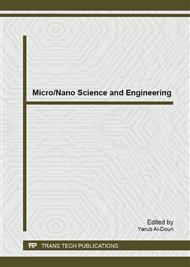[1]
M. Vallet-Regí and D. Arcos, Biomimetic Nanoceramics in Clinical Use: From Materials to Applications. Royal Society of Chemistry, (2008).
DOI: 10.1039/9781847558923-fp011
Google Scholar
[2]
M. Debnath, P. S. Bisen, and G. B. K. S. Prasad, Molecular Diagnostics: Promises and Possibilities. Springer, (2010).
Google Scholar
[3]
B. D. Malhotra and A. Turner, Advances in Biosensors: Perspectives in Biosensors. Elsevier Science, (2003).
Google Scholar
[4]
F. Scheller and F. Schubert, Biosensors. Elsevier Science, (1991).
Google Scholar
[5]
Biological and biomedical nanotechnology, vol. 1, no. 3. 2006, p.51.
Google Scholar
[6]
D. P. Kern, Nanostructure Fabrication, in Low-Dimensional Electronic Systems SE - 11, vol. 111, G. Bauer, F. Kuchar, and H. Heinrich, Eds. Springer Berlin Heidelberg, 1992, p.120–133.
Google Scholar
[7]
W. E. I. He, K. E. Gonsalves, and C. R. Halberstadt, Micro / Nanomachining and Fabrication of Materials for Biomedical Applications. 2008, p.25–47.
DOI: 10.1002/9780470185834.ch2
Google Scholar
[8]
P. Van Zant, Microchip Fabrication: A Practical Guide to Semiconductor Processing. McGraw-Hill, (2000).
Google Scholar
[9]
X. Chen, Z. Guo, G. M. Yang, J. Li, M. Q. Li, J. H. Liu, and X. J. Huang, Electrical nanogap devices for biosensing, Materials Today, vol. 13, no. 11, p.28–41.
DOI: 10.1016/s1369-7021(10)70201-7
Google Scholar
[10]
R. Doering and Y. Nishi, Handbook of Semiconductor Manufacturing Technology. CRC Press, (2008).
Google Scholar
[11]
B. Ziaie, Hard and soft micromachining for BioMEMS: review of techniques and examples of applications in microfluidics and drug delivery, Advanced Drug Delivery Reviews, vol. 56, no. 2, p.145–172, Feb. (2004).
DOI: 10.1016/j.addr.2003.09.001
Google Scholar
[12]
A. J. D. Plummer, M. D. Deal, and P. B. G, Silicon VLSI Technology Fundamentals , Practice and Modeling. (2000).
Google Scholar
[13]
T. H. S. Dhahi, U. D. A. B. I. N. Hashim, N. M. Ahmed, and A. M. A. T. Taib, A review on the electrochemical sensors and biosensors composed of nanogaps as sensing material, Journal of Optoelectronics and Advanced Materials, vol. 12, no. 9, p.1857–1862, (2010).
Google Scholar
[14]
T. S. Dhahi and U. Hashim, Anisotropic Dry Etching ( RIE ) for Micro and Nanogap Fabrication, International Journal of Modern Engineering Research, vol. 2, no. 1, p.9–15.
Google Scholar
[15]
K. L. Foo, U. Hashim, H. Prasad, and M. Kashif, Fabrication and characterization of IDE ZnO thin films using sol-gel method for PBS solution measurement, in 2012 10th IEEE International Conference on Semiconductor Electronics, ICSE 2012 - Proceedings, 2012, p.736.
DOI: 10.1109/smelec.2012.6417248
Google Scholar
[16]
N. Taib, U. Hashim, A. Saifullah, T. S. Dhahi, and J. K. Setar, Polysilicon Nanogap capacitive biosensors for the pH detection, vol. 1, p.250–252, (2011).
DOI: 10.1109/rsm.2011.6088335
Google Scholar
[17]
U. Hashim, K. A. Rahman, and A. R. A. J. Abdullah, Mask design and fabrication of LiSFET for Light Sensor application, 2008 International Conference on Electronic Design, p.1–5, Dec. (2008).
DOI: 10.1109/iced.2008.4786651
Google Scholar
[18]
T. S. Dhahi, U. Hashim, N. M. Ahmed, E. Ali, and T. Nazwa, Electrical characterization of in-house fabricated polysilicon micro-gap for yeast concentration measurement, Journal of Engineering and Technology Research, vol. 3, no. August, p.246–254, (2011).
Google Scholar
[19]
K. L. Foo, M. Kashif, and U. Hashim, Design and fabrication of nano biologically sensitive field-effect transistor (nano bio-FET) for bio-molecule detection, in AIP Conference Proceedings, 2011, vol. 1341, p.283–288.
DOI: 10.1063/1.3587002
Google Scholar


